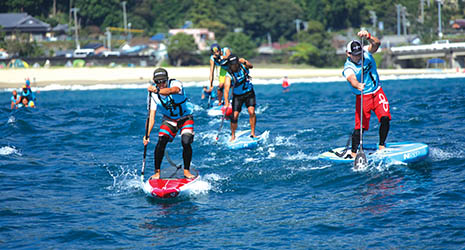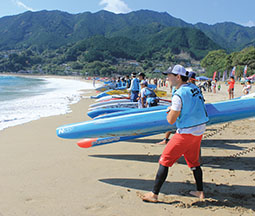Home > Highlighting JAPAN > Highlighting Japan June 2018 > Regional Revitalization through Sports
Highlighting JAPAN


A Seaside Town Creates Its Own High Tide
A seaside town that was losing ground as younger tourists and other beach-goers faded from its shores is using events that merge marine sports and natural attractions to improve its fortunes.
Ensconced in a great natural landscape of picturesque mountains in the city of Kumano, Mie Prefecture, Atashika Beach is known for white sands and shallow waters that stretch out far from shore. Atashika appeared on the Ministry of the Environment’s “Best Beach 100 of Japan” list in 2006, and formerly drew legions of beach-goers every summer. Due to the recent diversification of leisure, however, there are fewer visitors turning up—especially younger ones. According to the Japan Productivity Center’s Leisure white paper, Japan’s domestic beach-goer numbers peaked in 1985 at 37.9 million people, and had fallen to just 7.6 million people by 2015. Atashika is no exception to this depressing trend, with visitor numbers dropping year by year.
In 2011, Kumano City office staff reacted to the situation by setting up the Kumano Marine Sports Promotion Committee, bringing together experts in marine sports to devise a strategy to attract tourists and boost Kumano’s fortunes.
In March 2012, they staged the Kumano Sea Kayak Marathon with the help of local fishermen and other marine industry stakeholders. Three classes were set, from one for beginners held in the calm waters of the bay to an advanced class in the seas off Atashika, allowing kayakers to fully experience the natural environment. The first-time event had twenty-two participants.
They switched the timing of the event to October in 2013, and in 2014 added an event featuring stand-up paddleboarding (SUP), which is easy enough even for beginners, drawing over two hundred participants. In 2015, the event’s name was changed to Beach Marine Sports Festival in Atashika.
Sakie Onishi, a SUP instructor and member of the Kumano Marine Sports Promotion Committee, was a competitor in Atashika’s SUP marathon event.
“I participated twice in a row from 2014,” she says, “and fell in love with Kumano’s beautiful natural environment. When I found out that Kumano was recruiting members for its Local Vitalization Cooperator [see here], I immediately applied and moved to Kumano.” These members aim to attract people to regions with decreasing or aging populations, and help them get established and settle through community-run projects.
After joining Kumano’s Local Vitalization Cooperator, Onishi went to similar events in other regions as an observer while pondering ways to upgrade Kumano’s event based on her experience as a competitor.
“We got the local women’s association to assist us, and served regional dishes such as ‘mehari sushi’ (rice wrapped in pickled mustard leaf) and mackerel sushi to participants after the event,” Onishi says. “We also paid attention to details such as making the buoys that marked out the course easier to see, and tried to improve anything we thought could be made better.”
On the day of the event, the organization set up SUP tryouts, beach soccer, beach tennis and other activities for people who weren’t competing. The event grew to the point that the world SUP champion came from overseas to participate. In 2016, the Japan Sports Agency’s “Revitalization of Regional Communities and the Economy Through Sport” report [see here] listed the event as a successful case study, drawing many observers from other regions to see for themselves.
“We want to anchor the meet as an event on Kumano’s autumn calendar,” says Koichi Ono, an officer of the Sports Networking Division at the Kumano City Tourism Board about the success of previous events and upcoming plans. “We want to both increase the number of participants and expand outside marine sports into sports that use the city’s other natural gifts to revitalize the region. For example, in 2017 we staged a bouldering event on the crags in the city, which the city also supported.”
Kumano is rich in tourist attractions, beginning with the World Heritage Site of Kumano Kodo—an ancient Japanese pilgrimage trail—and the rocky wonders of outcroppings such as Onigajo and Hana no Iwaya. The city is working on guided tours to showcase such locations to people visiting Kumano thanks to its high-profile sporting events.
© 2009 Cabinet Office, Government of Japan







